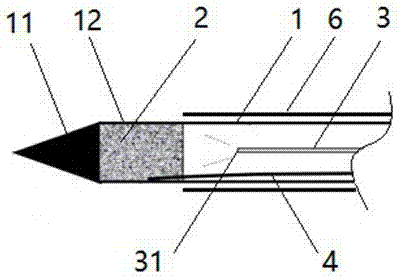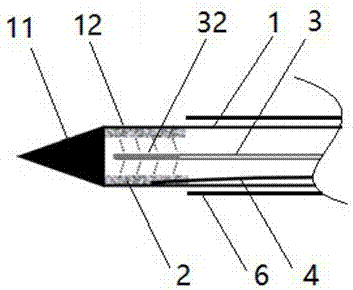Photothermal therapy probe based on photothermal nanomaterial
A nanomaterial and photothermal therapy technology, applied in the field of medical devices, can solve the problems of inability to achieve therapeutic effects, low photothermal conversion efficiency, etc., and achieve the effects of simple structure, small wound surface, and convenient operation.
- Summary
- Abstract
- Description
- Claims
- Application Information
AI Technical Summary
Problems solved by technology
Method used
Image
Examples
Embodiment 1
[0031] Experiment on heating egg white solution
[0032] The photothermal nanomaterial 2 of the present invention is selected to fill the space of the photothermal material filling area 12, and the end of the optical fiber 3 is a direct type 31 ( figure 2 ); the region of the probe head 11 and 12 of the present invention is inserted into 1 ml of egg white solution, the wavelength of the laser source is 808 nanometers of continuous laser, the laser output power is 1 watt, and the irradiation time is 10 minutes. Figure 4 It can be seen that this embodiment proves that the present invention can effectively increase the temperature of the egg white solution around the probe and impel the denaturation of the egg white protein (such as Figure 4 ).
Embodiment 2
[0034] Tumor Killing Experiments in Mouse Tumor Models
[0035] In order to further confirm that the present invention can be used for clinical treatment. A subcutaneous mouse tumor model was established. The photothermal nanomaterial 2 of the present invention is selected to fill the space of the photothermal material filling area 12, and the end of the optical fiber 3 is a direct type 31 ( figure 2 ); insert the probe heads 11 and 12 of the present invention percutaneously into the tumor, and then perform photothermal treatment (the laser output power is 1 watt, and the irradiation time is 5 minutes). Figure 5 It has been shown that the photothermal therapy probe can effectively heat the lesion site of the tumor tissue to a temperature above 50 degrees Celsius to achieve the purpose of ablation of the tumor.
PUM
 Login to View More
Login to View More Abstract
Description
Claims
Application Information
 Login to View More
Login to View More - R&D
- Intellectual Property
- Life Sciences
- Materials
- Tech Scout
- Unparalleled Data Quality
- Higher Quality Content
- 60% Fewer Hallucinations
Browse by: Latest US Patents, China's latest patents, Technical Efficacy Thesaurus, Application Domain, Technology Topic, Popular Technical Reports.
© 2025 PatSnap. All rights reserved.Legal|Privacy policy|Modern Slavery Act Transparency Statement|Sitemap|About US| Contact US: help@patsnap.com



